Abstract
Described is an epidemiological investigation of hookworm infections in a rural community in Zimbabwe, where Necator americanus is the only human helminth species present. Among a cohort of 120 individuals the overall prevalence of infection was 78%. Intensity of infection was quantified both as egg counts (range: 0-2563 eggs per g of stool) and worm burden (range: 0-100 worms). Although both these measures provide useful quantitative data, they are tedious to determine in large-scale epidemiological studies and may present social and logistic difficulties. As an alternative screening method, we therefore investigated isotype-specific responses to adult worm antigens of N. americanus. The results show that specific IgG4 responses correlate positively and significantly with both measures of intensity and may be a useful marker of hookworm infection.
Full text
PDF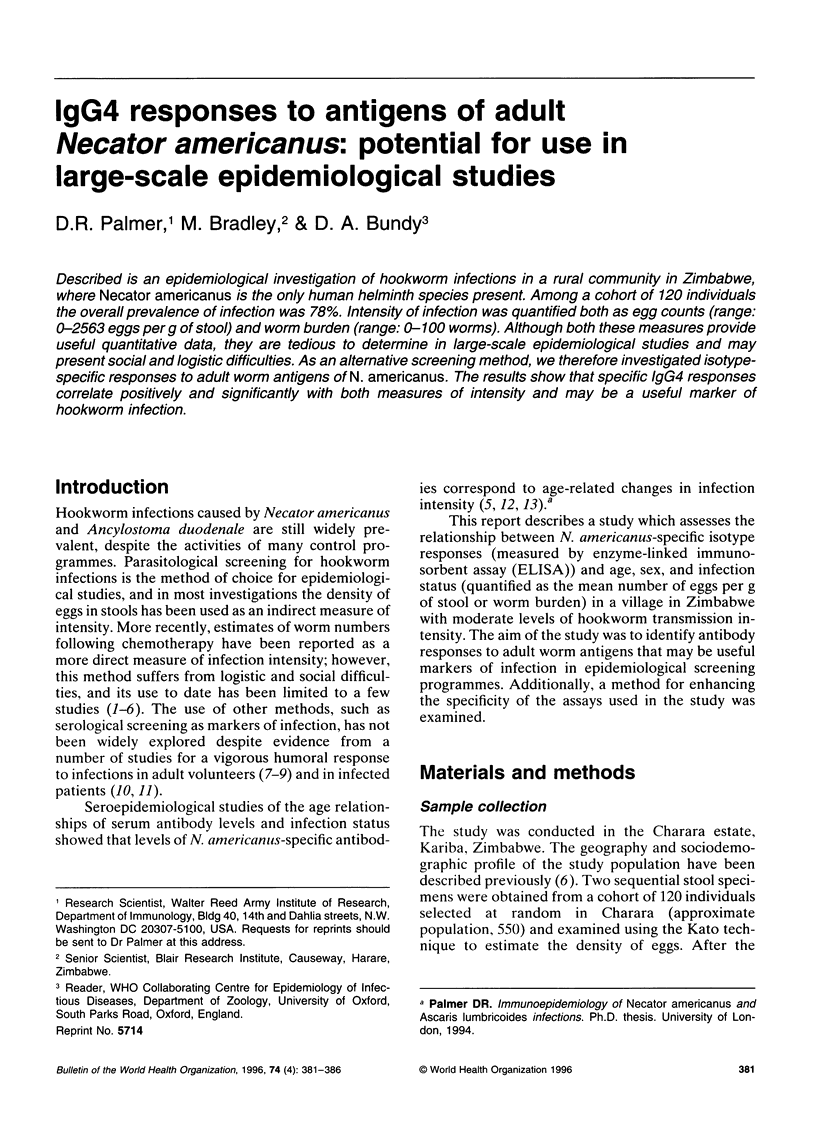
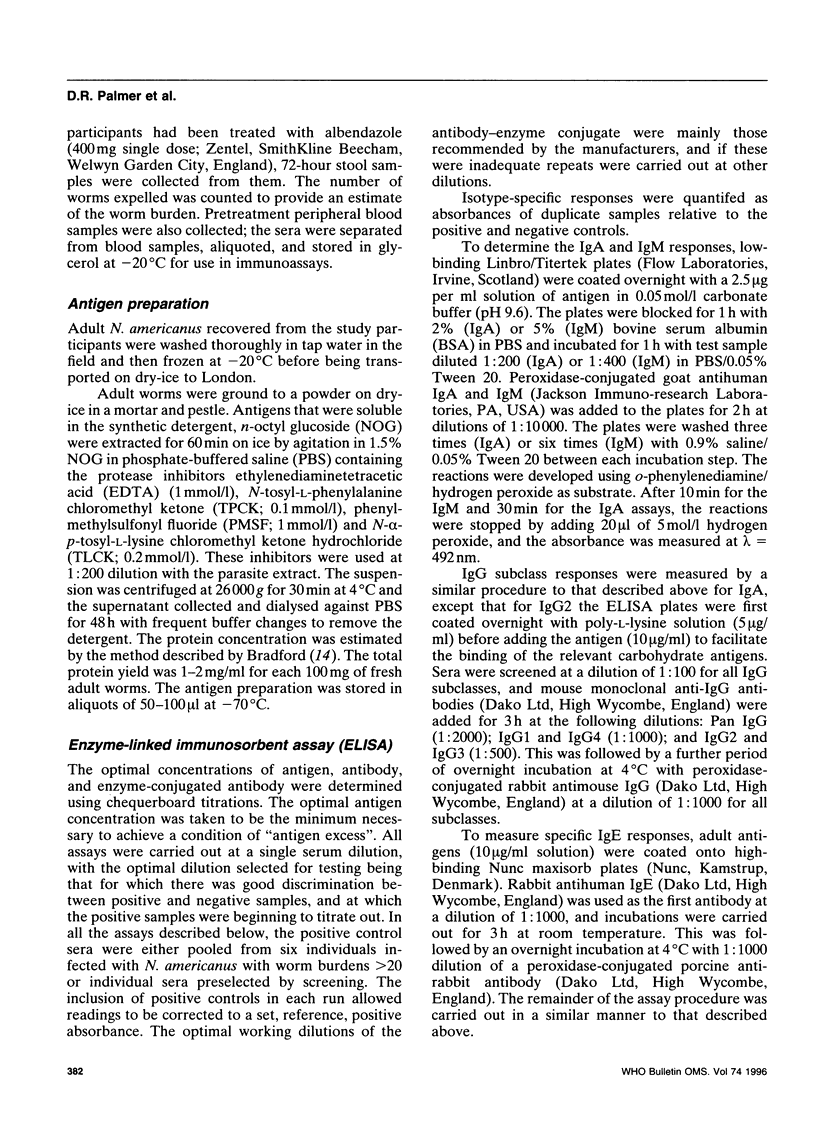
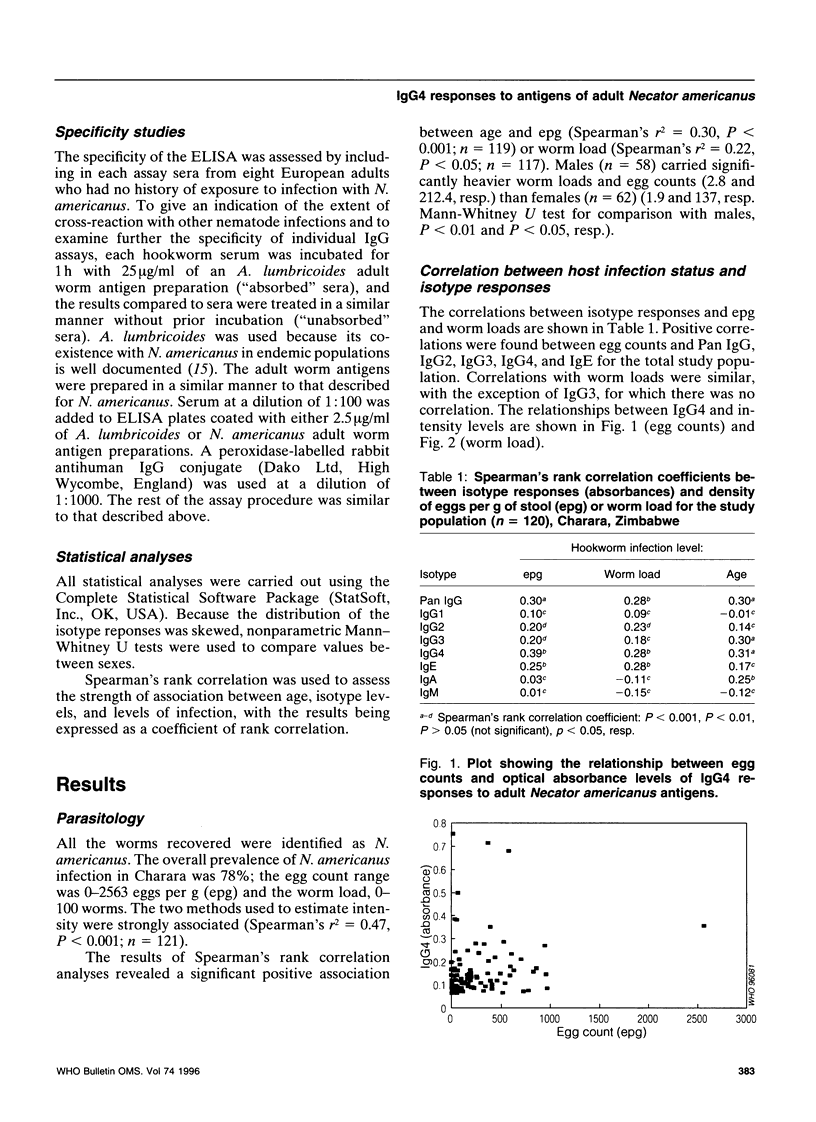
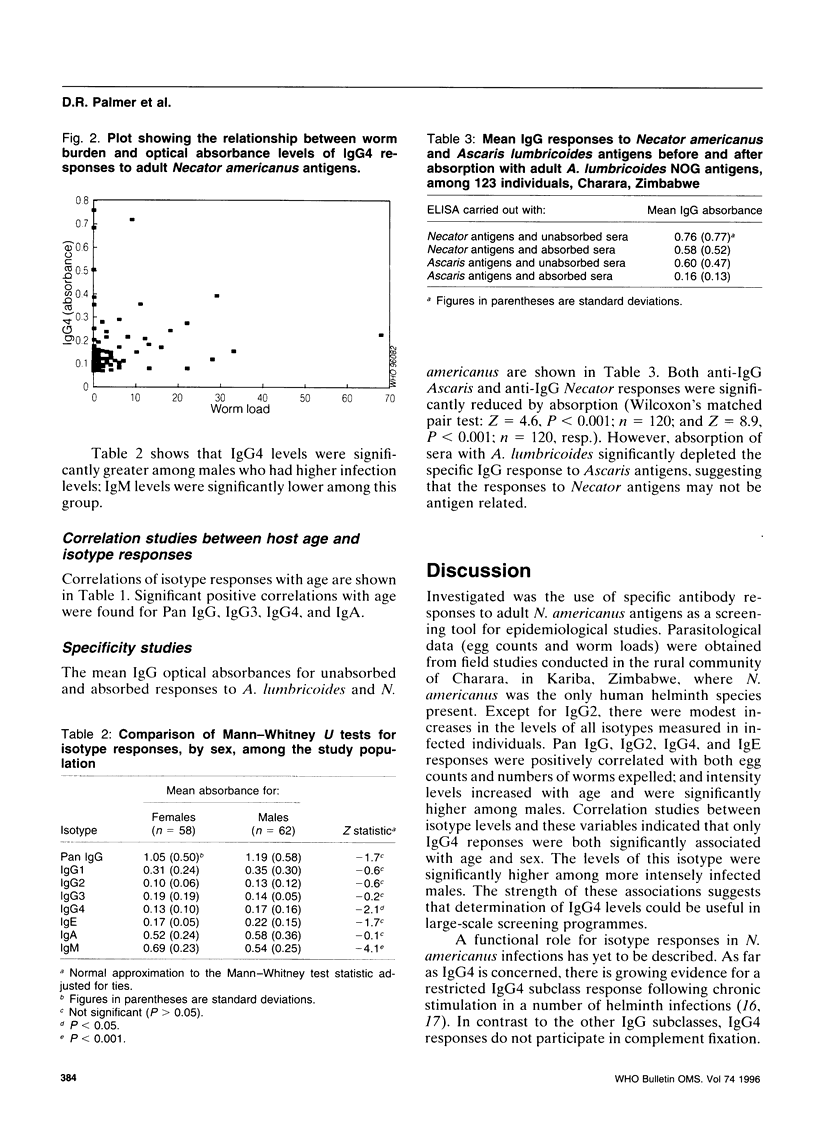

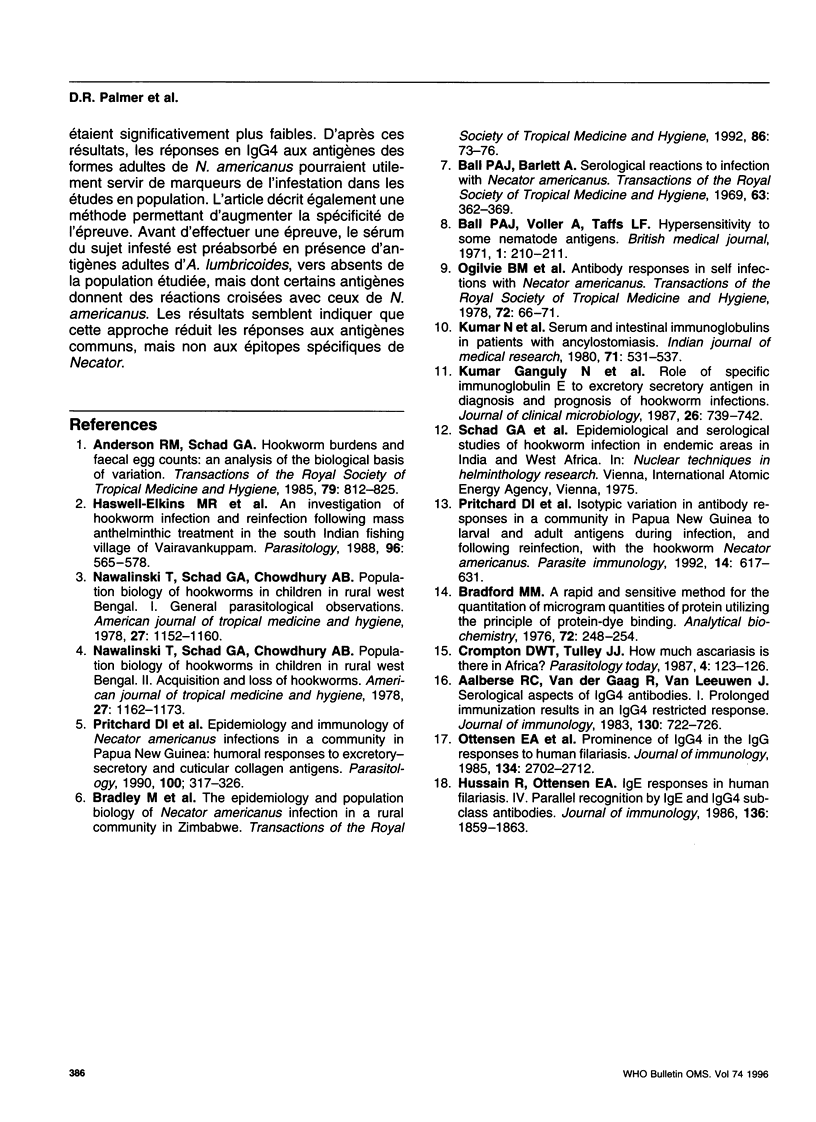
Selected References
These references are in PubMed. This may not be the complete list of references from this article.
- Aalberse R. C., van der Gaag R., van Leeuwen J. Serologic aspects of IgG4 antibodies. I. Prolonged immunization results in an IgG4-restricted response. J Immunol. 1983 Feb;130(2):722–726. [PubMed] [Google Scholar]
- Anderson R. M., Schad G. A. Hookworm burdens and faecal egg counts: an analysis of the biological basis of variation. Trans R Soc Trop Med Hyg. 1985;79(6):812–825. doi: 10.1016/0035-9203(85)90128-2. [DOI] [PubMed] [Google Scholar]
- Ball P. A., Bartlett A. Serological reactions to infection with Necator americanus. Trans R Soc Trop Med Hyg. 1969;63(3):362–369. doi: 10.1016/0035-9203(69)90011-x. [DOI] [PubMed] [Google Scholar]
- Ball P. A., Voller A., Taffs L. F. Hypersensitivity to some nematode antigens. Br Med J. 1971 Jan 23;1(5742):210–211. doi: 10.1136/bmj.1.5742.210. [DOI] [PMC free article] [PubMed] [Google Scholar]
- Bradford M. M. A rapid and sensitive method for the quantitation of microgram quantities of protein utilizing the principle of protein-dye binding. Anal Biochem. 1976 May 7;72:248–254. doi: 10.1006/abio.1976.9999. [DOI] [PubMed] [Google Scholar]
- Bradley M., Chandiwana S. K., Bundy D. A., Medley G. F. The epidemiology and population biology of Necator americanus infection in a rural community in Zimbabwe. Trans R Soc Trop Med Hyg. 1992 Jan-Feb;86(1):73–76. doi: 10.1016/0035-9203(92)90448-l. [DOI] [PubMed] [Google Scholar]
- Crompton D. W., Tulley J. J. How much Ascariasis is there in Africa? Parasitol Today. 1987 Apr;3(4):123–127. doi: 10.1016/0169-4758(87)90054-8. [DOI] [PubMed] [Google Scholar]
- Ganguly N. K., Mahajan R. C., Sehgal R., Shetty P., Dilawari J. B. Role of specific immunoglobulin E to excretory-secretory antigen in diagnosis and prognosis of hookworm infection. J Clin Microbiol. 1988 Apr;26(4):739–742. doi: 10.1128/jcm.26.4.739-742.1988. [DOI] [PMC free article] [PubMed] [Google Scholar]
- Haswell-Elkins M. R., Elkins D. B., Manjula K., Michael E., Anderson R. M. An investigation of hookworm infection and reinfection following mass anthelmintic treatment in the south Indian fishing community of Vairavankuppam. Parasitology. 1988 Jun;96(Pt 3):565–577. doi: 10.1017/s0031182000080197. [DOI] [PubMed] [Google Scholar]
- Hussain R., Ottesen E. A. IgE responses in human filariasis. IV. Parallel antigen recognition by IgE and IgG4 subclass antibodies. J Immunol. 1986 Mar 1;136(5):1859–1863. [PubMed] [Google Scholar]
- Kumar N., Gupta P. S., Saha K., Misra R. C., Agarwal D. S., Chuttani H. K. Serum and intestinal immunoglobulins in patients of ancylostomiasis. Indian J Med Res. 1980 Apr;71:531–537. [PubMed] [Google Scholar]
- Nawalinski T., Schad G. A., Chowdhury A. B. Population biology of hookworms in children in rural West Bengal. I. General parasitological observations. Am J Trop Med Hyg. 1978 Nov;27(6):1152–1161. doi: 10.4269/ajtmh.1978.27.1152. [DOI] [PubMed] [Google Scholar]
- Nawalinski T., Schad G. A., Chowdhury A. B. Population biology of hookworms in children in rural West Bengal. II. Acquisition and loss of hookworms. Am J Trop Med Hyg. 1978 Nov;27(6):1162–1173. doi: 10.4269/ajtmh.1978.27.1162. [DOI] [PubMed] [Google Scholar]
- Ogilvie B. M., Bartlett A., Godfrey R. C., Turton J. A., Worms M. J., Yeates R. A. Antibody responses in self-infections with Necator americanus. Trans R Soc Trop Med Hyg. 1978;72(1):66–71. doi: 10.1016/0035-9203(78)90303-6. [DOI] [PubMed] [Google Scholar]
- Pritchard D. I., Quinnell R. J., Slater A. F., McKean P. G., Dale D. D., Raiko A., Keymer A. E. Epidemiology and immunology of Necator americanus infection in a community in Papua New Guinea: humoral responses to excretory-secretory and cuticular collagen antigens. Parasitology. 1990 Apr;100(Pt 2):317–326. doi: 10.1017/s0031182000061333. [DOI] [PubMed] [Google Scholar]
- Pritchard D. I., Walsh E. A., Quinell R. J., Raiko A., Edmonds P., Keymer A. E. Isotypic variation in antibody responses in a community in Papua New Guinea to larval and adult antigens during infection, and following reinfection, with the hookworm Necator americanus. Parasite Immunol. 1992 Nov;14(6):617–631. doi: 10.1111/j.1365-3024.1992.tb00034.x. [DOI] [PubMed] [Google Scholar]


